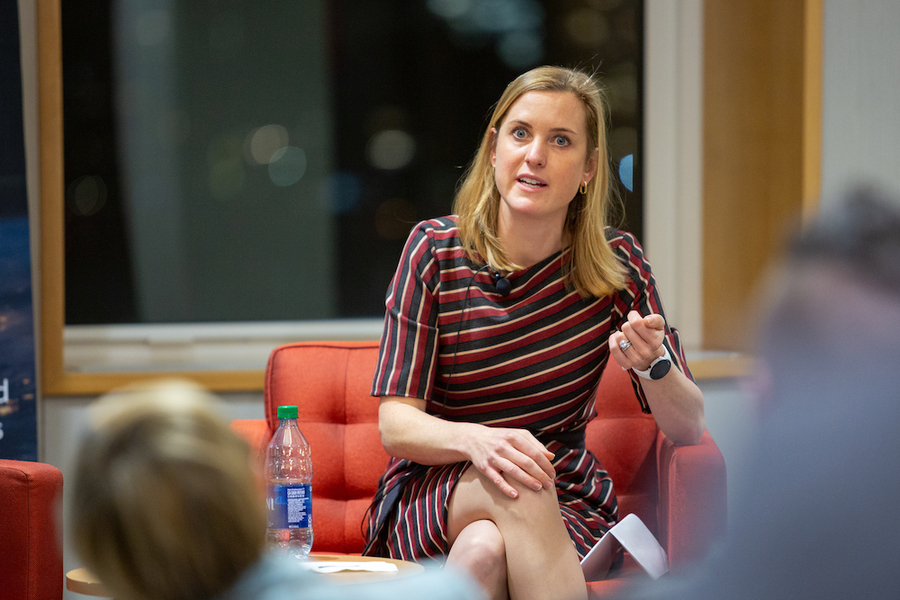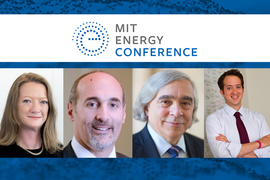Poppy Allonby, a senior financial executive and the former managing director of BlackRock, has been analyzing the link between climate change and investing for more than two decades. “For a lot of that, it was quite lonely,” Allonby said during her December address at the MIT Energy Initiative Fall Colloquium. “There weren’t that many other people looking at this field. And over the last three or four years, that’s completely changed.”
Increasingly, Allonby said, investors are opening their eyes to the long-term risks of climate change — risks that threaten not only the planet, but also their portfolios. And as more institutional investors come to see climate change as a threat to their beneficiaries, they are taking action to fight it. Still, she cautioned that much more work remains to be done.
“Various investors are at very different stages in considering climate change,” Allonby said. “Once they realize this is something they need to think about … they need to do a risk assessment, then develop a strategy.”
“When you look at different institutions,” she said, “some are just at the very beginning of this journey.”
A changing landscape
Although there is a compelling moral case to be made for taking steps to mitigate climate change, Allonby noted that institutional investors such as pension funds are bound by a fiduciary duty to their beneficiaries. That is to say, they are obligated to put their client or member interests ahead of their own.
“I talk about fiduciary duty, because one of the things that has really changed in the investment space is that more and more investors are beginning to see climate change and climate risk as [impacting] their fiduciary duty,” said Allonby. “That has been a shift. In my mind, it makes total sense. If you’re a long-term investor … and you’re thinking about beneficiaries that need assets over the next 10 or 20 years, and thinking about risks that might materialize — and climate change, in particular — then that makes a lot of sense. But that is not where we were five or 10 years ago.”
Allonby spent more than 20 years at the multinational investment management corporation BlackRock. For 17 of those years, she was a senior portfolio manager responsible for managing multibillion-dollar funds investing globally in companies across the traditional energy sector, and also those involved in sustainable energy and mitigating climate change. Most recently, she was head of the corporation’s Global Product Group on several continents, where she provided oversight for nearly $1 trillion assets and played a critical role in developing BlackRock’s sustainable product strategy.
“Where I like to think the finance industry is heading is integration,” she said. “This means thinking holistically about pretty much every decision you make as an investor, and thinking about how climate risk is going to impact that investment. That is a sea change in the mentality around how people invest.”
Divestment versus engagement
For many years, activists have pushed for institutions — including MIT — to divest from fossil fuel companies. By keeping fossil fuel companies out of their portfolios, these activists argue, institutions and individuals can exert social, political, and economic pressure on these corporations and help to accelerate the shift to renewable energy.
However, Allonby argued instead for ongoing engagement with fossil fuel companies, reasoning that this better positions investors to push for change. “My personal view with divesting from oil and gas companies is, that’s not very effective,” Allonby said. “I think there might be examples where you have very specific companies which you don’t think will be involved in the transition [to net zero], and [divestment] might make sense. Or if you’ve got an institutional investor where it is imperative that their investment is entirely aligned with their values — so, certain charities — it might make sense. But if you really care about change, I think you need to keep a seat at the table.”
In a way, Allonby said, divesting from fossil fuel companies lets leaders at those organizations off the hook, reducing the pressure on them to make meaningful changes to their operations. “Imagine a company that is incredibly polluting and not sustainable, and they have shareholders that are not happy, but they don’t do anything, and those shareholders decide to divest,” she said. “What happens as a result of that, potentially, is the company goes, ‘Oh, that was easy! I didn’t have to do anything, and [the activists] have gone away.’ And potentially, those assets end up being owned by people who care less. So that is a risk, when you think about divestment.”
Challenges and opportunities
Allonby outlined several challenges with climate-focused investing, but also noted a number of opportunities — both for investors looking to make money, and those looking to make a change.
Among the challenges: For one, some investors simply still need to be convinced that climate change is a problem they should be working to solve. Also, Allonby said, there is a lack both of a formalized methodology and of specialized investment products for climate-focused investing, although she noted that both of these areas are improving. Finally, she said, it remains a challenge to encourage investors to direct capital toward clean-energy projects in developing countries.
Investors can both set themselves up for financial success and mitigate climate change, Allonby said, through savvy investments in either distressed or underpriced assets. “If you can buy assets that are discounted or cheaper because people have real concerns about their environmental footprint, then you can work with those companies to improve it and therefore reduce the risk and improve the valuation,” she said.
Allonby, pointing to the high cost of waterfront property in areas that are vulnerable to rising sea levels, also suggested that the long-term risks of climate change have not been fully priced into many assets. “My view is that we haven’t really gotten our arms around that,” she said. “From a purely investment perspective, that’s also an opportunity.”
Additionally, Allonby noted the recent rise of ESG funds, which invest with environmental, social, and corporate governance guidelines in mind. Some of these funds, she noted, have outperformed the larger market over the past several years.
“When we talk about climate change, one has a range of emotions,” Allonby said. “Sometimes it can feel like we’re not making enough progress. And one of the nice things about being here at MIT is that whenever I’m here, I always feel hopeful about the future, and quite hopeful about all of the technologies and work that you are doing to transition energy systems and move things forward. When you look at what’s happening in the financial services sector, there’s still a huge amount to do, but it’s also quite a hopeful story.”










